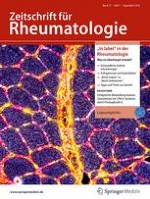Erschienen in:

08.08.2017 | Originalien
Relative efficacy and safety of apremilast, secukinumab, and ustekinumab for the treatment of psoriatic arthritis
verfasst von:
G. G. Song, Y. H. Lee, MD, PhD
Erschienen in:
Zeitschrift für Rheumatologie
|
Ausgabe 7/2018
Einloggen, um Zugang zu erhalten
Abstract
Objective
To assess the relative efficacy and safety of apremilast, secukinumab, and ustekinumab at different doses in patients with active psoriatic arthritis (PsA).
Method
A Bayesian network meta-analysis was conducted, which included randomized controlled trials (RCTs) that examined the efficacy and safety of apremilast 20 mg, apremilast 30 mg, secukinumab 75 mg, secukinumab 150 mg, secukinumab 300 mg, ustekinumab 45 mg, and ustekinumab 90 mg compared with placebo.
Results
Of the RCTs 8 comprising 3289 patients met the inclusion criteria. The American College of Rheumatology (ACR) 20 response rate was significantly higher in the secukinumab 300 mg group than in the placebo group (odds ratio OR, 7.55; 95% confidence interval CI, 3.18–17.63). Secukinumab 150 mg, secukinumab 75 mg, ustekinumab 90 mg, apremilast 30 mg, apremilast 20 mg, and ustekinumab 45 mg were also more efficacious than placebo. There were no significant differences in the efficacy between the interventions. A dose-response relationship among the same drug groups was observed. The number of serious adverse events was not significantly different among the apremilast, secukinumab, ustekinumab, and placebo groups.
Conclusion
All drug treatments were more efficacious than placebo; however, there were no significant differences in the efficacy and safety between the drugs at the different doses.